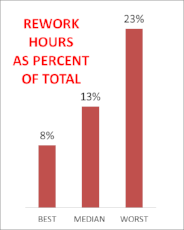 Most design firms see themselves as unable to break through the downward fee pressure created by clients and their agents. They pound their heads on the commoditization wall, and resign themselves to working for substandard fees.
Most design firms see themselves as unable to break through the downward fee pressure created by clients and their agents. They pound their heads on the commoditization wall, and resign themselves to working for substandard fees.
What they don’t see are the ways to increase profits without increasing fees, other than working more hours for less. There really are alternatives!
Stamp out rework
There are many metaphors for rework, but my favorite is this: Rework is a giant tapeworm down in the bowels of your practice, munching on your profits. From time to time you see evidence it’s in there, but mostly it stays out of sight.
First: What rework is not: Rework is not extra work that turns into paid scope change (change orders). It is not the iterative process in design. Rework is doing again something you’ve already done, but can’t get paid for. How big is rework? The vast majority of firms have no idea, because they don’t measure it. One firm that does measure it found it varied from 8% to 23% of total project hours, with a median of 13% (see illustration below).
 RECENT EXAMPLE:
RECENT EXAMPLE:
• 28 PROJECTS
• OVER A CALENDAR YEAR
• RANGE OF FEE SIZES
• ALL LESS THAN 6 MONTHS IN DURATION
Almost all project managers, when asked, say they think rework is somewhere between 5% and 50% of total project hours, but the most common answer is 15%-20%.
What most firms don’t realize is that every hour of rework comes straight off bottomline profit at full chargeout rates – because it’s an hour of time you can’t sell to another client.
So let’s say your EBBT profit level is 12.5%, and you are spending 15% of your hours on rework. If you could cut rework in half, your profitability would go up to 20% - without doing anything else differently.
Actions You Can Take
You can never stamp out rework completely, but you can get it under control, for huge benefit to the bottom line. Here is how to do it – and you need all these steps.
1. Start measuring rework, on every project, all the time, with a “rework” line item on your timesheets and in your accounting system.
2. Make it very clear to all staff that most rework is not caused by mistakes, but by poorly managed design processes and failing to get paid for scope change. Emphasize the importance of putting real rework numbers down, as it is the only way to analyze the problem and start to solve it.
3. If there is any vestige of a “blame” culture in senior firm leadership, eradicate it firmly and completely. If you don’t, staff will never be honest about the real extent of rework – they will equate it to “making mistakes” and hide it.
4. Once that’s all working, start to code the rework as to source, with a simple letter system, like A, B, C, etc. – where each letter stands for a rework group, like A = Client changes for free.
5. Export and analyze the rework history, identifying areas ripe for improvement, then implement change. Make your first goal a 50% reduction. Compare rework for different project types, and different clients. Find out where the tapeworm lives, and kill it.
About the Author: Charles Nelson is an Instructor, Project Management and Consultant, M&A and Strategic Planning for PSMJ. He has been involved with the architecture/engineering design and construction industry for more than 40 years, including a decade as the owner/manager of a Boston based design/build firm. He can be reached at cnelson@psmj.com
This article is an excerpt from the article, "Five Ways to Raise Your Profits," in the July issue of the PSMJ newsletter. If you are ready to see why more and more architecture and engineering firm leaders look here for that next great idea:
Also check out these sample articles from the PSMJ newsletter:
Need to Know: Strategy Lessons From Moneyball
Debunking Key Misconceptions of Design-Build
Marketing Spend: Are your budgets targeted for growth?
Decision Making: Does Size Matter?
Where are the Design Professions Headed?



